An A-Z of Westerham's Notable People
This page has entries for many of Westerham's people, in alphabetic order. Many entries will have links to more detailed entries or stories that help you discover the fabric of society in Westerham's past.
The project is work in progress, so more photos and stories will appear over the coming months.
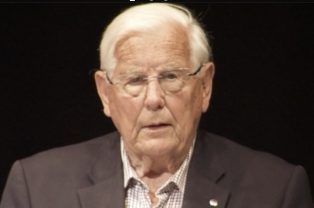 ANCKORN Fergus
ANCKORN Fergus
"...When I came home from the war I didn’t want to work. I’d been a prisoner of war not expecting to live, and I came home and realised that I was actually alive - I remember thinking at one time I would never be twenty-five, but I’d survived. What did I want a job for? If I wanted something to eat, there was a huge field of potatoes on the farm down the road - I was just glad to be alive, and just thought what a wonderful place the world was…
I came to my senses after a while and got the job at Redlands. When we’d moved to Westerham, my wife had a full-time job working as a nurse and to add to our income, to pay the mortgage, I had started teaching night classes in Shorthand and French at West Kent College in Tonbridge. Well, one day they offered me two lectureships to teach the subjects as a full-time job for twenty pounds a week - imagine that! I didn’t know what to do, it was a lot of money but I didn’t feel confident that I could do it and told them so at the College. ‘We know all about you Mr Anckorn’ they said ‘we’ve seen how you teach your night classes, you’ll be fine.’ I spoke to my wife and asked her what I should do and she reminded me about a time when we’d watched a little squirrel launch himself from one tree to another to cross four railway tracks at Sevenoaks in a complete ‘leap of faith.’
‘Just jump’ she said, so I did, and never looked back. In the end my wife taught there as well, and both our children were students there, so we would all set off together as a family each day, and take the dog as well. The dog learned my timetable in a fortnight and knew when my free periods were. When I had a free period I would go out and give him a bun and take him for a walk in the woods. In the lunch hour, the whole family would go down to the woods by the river and have a picnic, and watch the kingfishers flying over the water. I would have done it all for no pay, it was so delightful - the students actually wanted to learn in those days, and would ask for extra homework.
I remember us all talking in the prison camp one day, we were discussing what we would do if we survived and I said to the others ‘my dad has a little summer house at the bottom of our lawn and if he will let me have that, I’d put a carpet in and put a door on it and that’s all I would need in the world …’ - all I wanted was shelter and a little place of my own, it’s finding out all the things you do not need that’s important. All I had in the way of clothing for four years was a loin-cloth, which I’ve still got - who wants ten suits? - who needs a car? - just a life, that’s all you need. I was happy, but the war spoilt it. I was asked recently if I hated the Japanese and the answer is no, I didn’t hate them, I hated the war..."
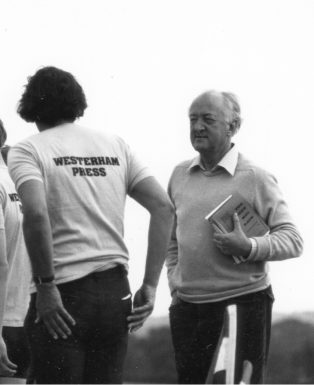 ATTERBURY Rowley
ATTERBURY Rowley
Rowley Streatfeild Atterbury was born in Eastbourne in 1920. On leaving school he joined the RAF where he trained in engineering. At the end of the war Atterbury found work as a print manager at Faber & Faber in London. By then living in Westerham with his wife Audrey, he spent weekends experimenting with a small printing press in 'the chicken-shed', a large lock-up garage in Buckham Thorns rented from his aunt, Sylvia Streatfeild. This was to become the beginning of 'Westerham Press' which he founded in 1949-50 in a small cottage beside Charlie Sharp's garage in the High Street where 'Squerryes Mead' is today. From the outset, Rowley's mission statement was 'high-quality printing allied to good design' and this was to remain at the heart of all that was produced under the guidance of this remarkable visionary over the next thirty-four years...
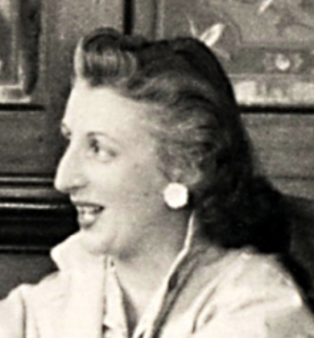 ATTERBURY Audrey
ATTERBURY Audrey
Audrey Atterbury nee Holman, married Rowley Atterbury in 1943. When Rowley started Westerham Press in 1949, his wife worked alongside him in the business. She was, however, to meet Freda Lingstrom, the newly appointed head of BBC Children’s Television, by chance on a train the following year and the two struck up a conversation. Lingstrom outlined her plans for a new television series to be called Andy Pandy. Atterbury was intrigued with the project and Lingstrom persuaded her to train as a puppeteer and work on the new programme. Audrey's new found skill was to work with great effect, and following the breakdown of her marriage to Rowley in 1956 she moved to north London. The 'Watch with Mother' series grew to include the 'Flower Pot Men', 'Rag, Tag and Bobtail' and 'The Wooden Tops'. Audrey worked on all of these alongside Molly Gibson, another puppeteer who became a very close friend.
BARTLETT Henry Charles 1825 - 1907
Vicar of St Mary's Church Westerham from 1860 to 1900. 'The Living' for Westerham's Vicar at that time was still the Vicarage where James Wolfe had been born in 1727. Revd. Bartlett was a significant landowner in the town around the area north-west of today's Croydon Road, then called Rysted Lane. It was the sale of a large area of this mixed orchard to the builder Thomas Weller that allowed Weller to build his showcase development which became Westbury Terrace.
Extract form his obituary: “…although as far as his health permitted him, Mr Bartlett continued to take an active interest in many local institutions, his resignation as Vicar marked his retirement as vice-chairman and trustee of the Moreton almshouses, and also as chairman of the Managers of the National Schools. To Mr Bartlett we are indebted for the New Street Almshouses – an institution which he was instrumental in erecting by subscription many years ago. During his term of office many improvements and enlargements were made to the National Schools. When Mr Bartlett became Vicar there was but one mixed school, situated at Hosey; and it was greatly owing to his efforts that the girls school near the station were erected by voluntary contribution. But a greater and far more important work during the Vicarship of the late Mr. Bartlett was the restoration of the Parish Church, which was carried out in 1883, at a cost of £5,000.
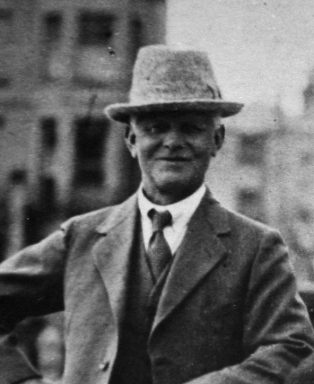 BENSON Frederick
BENSON Frederick
A commercial photographer and taxidermist who moved to Westerham in 1898. He initially operated his business from Roseville in the High St, then moving across the road to a new-build next door to New Rose Villa, the house Thomas Weller had built for his own family. This new house was to be Benson's 'Keswick Studios' where he did most of his portrait work until his death in 1938. His distinctive photographs provide a large part of our archives. Here is a photograph of him with Westerham's diarist Harry Streatfeild taken in Tunbridge Wells in the early 1920s. Winston Churchill favoured the work of Benson for his personal photographs of the family.
BIRD Maria
 Maria Bird lived with her companion Freda Lingstrom at Chartwell Cottage where they set up a company called 'Westerham Arts'. Both working for the BBC, they developed the concept of 'Watch with Mother' and the characters within the strand, including Andy Pandy and the Flower Pot Men. A chance meeting and the subsequent conversation on a train between Lingstrom and another of the town's commuters Audrey Atterbury, inspired Atterbury to involve herself with Westerham Arts and train as a puppeteer. She worked on the Watch with Mother series which began in 1951 with Andy Pandy.
Maria Bird lived with her companion Freda Lingstrom at Chartwell Cottage where they set up a company called 'Westerham Arts'. Both working for the BBC, they developed the concept of 'Watch with Mother' and the characters within the strand, including Andy Pandy and the Flower Pot Men. A chance meeting and the subsequent conversation on a train between Lingstrom and another of the town's commuters Audrey Atterbury, inspired Atterbury to involve herself with Westerham Arts and train as a puppeteer. She worked on the Watch with Mother series which began in 1951 with Andy Pandy.
BOND Harry H
Was proprietor of the Wolfe Garage in the High St in 1926. He was an opportunist who kept up with the latest technologies. See advert for his Westerham business in 1926 which shows he is selling wireless sets, only three years after the BBC started broadcasting. A popular figure in Westerham , Harry Bond would often take part in the Westerham Gala.
CHURCHILL
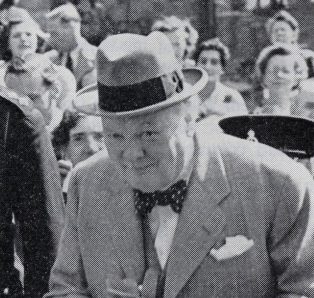 Winston Churchill bought Chartwell in 1922 and lived there until his death in 1965. It was there that he wrote his books, painted and entertained dignitaries and friends from all over the world. He was often heard to remark that a day away from Chartwell was a day wasted. The often-needed quiet moments of thinking would be spent beside the fish pond where he fed his golden orfe. Visit the Churchill page here. Chartwell is now one of the National Trust's most popular properties. Click here to visit the NT website.
Winston Churchill bought Chartwell in 1922 and lived there until his death in 1965. It was there that he wrote his books, painted and entertained dignitaries and friends from all over the world. He was often heard to remark that a day away from Chartwell was a day wasted. The often-needed quiet moments of thinking would be spent beside the fish pond where he fed his golden orfe. Visit the Churchill page here. Chartwell is now one of the National Trust's most popular properties. Click here to visit the NT website.
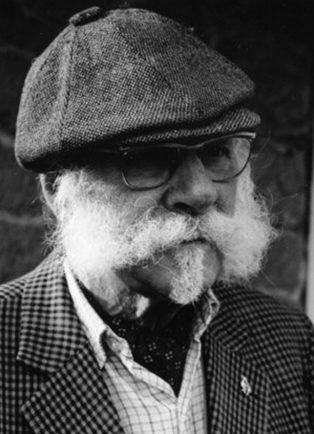 DOWNS Donald
DOWNS Donald
A well-known and popular, if seemingly eccentric character, Donald was a writer, poet, artist and leading authority on fly-fishing. Of Scottish ancestry - lineage of which he was very proud - Donald himself was born the only child of John and Edna Downs at French Street in 1924. A man who shunned many of the trappings of the modern age, Donald did not own a car, even though during his war service he had driven most things from a Jeep to a Churchill tank. He enjoyed listening to the wireless, but would not entertain the like of television, or even a refrigerator. He was very happy in his own company, and would walk daily from his house at the top of Hosey Hill to shop in the town for his supper.
Donald was very interested in the history of Westerham and wrote many articles and pamphlets about the town in years gone by. They would be hand-written, in his distinctive cursive Italic, always using a fountain-pen with a broad nib. See photos and press cuttings
DUMARESQ Charles and Ann Flora
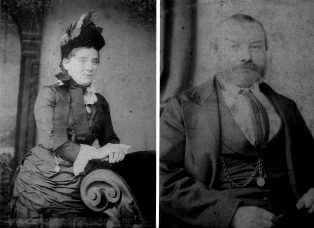 Lived at 'Colpetty' on Westbury Terrace. In 1902 Ann was recorded as the legal owner of the house, an unusual situation at the time, as Charles was working as senior bank clerk in the National & County Bank, and Ann did not work. We know little else, except that their daughter Annie Georgina played lead violin on occasion in locally held concerts. See concert programme notes for a concert organised by the Men's Club in 1912
Lived at 'Colpetty' on Westbury Terrace. In 1902 Ann was recorded as the legal owner of the house, an unusual situation at the time, as Charles was working as senior bank clerk in the National & County Bank, and Ann did not work. We know little else, except that their daughter Annie Georgina played lead violin on occasion in locally held concerts. See concert programme notes for a concert organised by the Men's Club in 1912
EVENDEN Edward
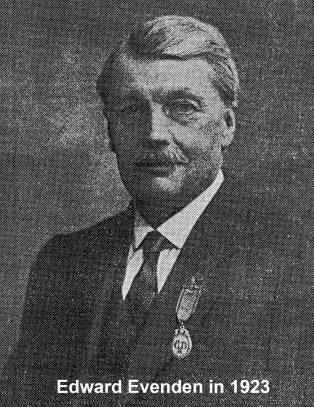 Edward Evenden started his working life as a bank clerk in the Sevenoaks area, but was a practical man 'good with his hands'. Studious ledger-entry clearly didn't inspire the young Mr. Evenden so he took a job as apprentice to Herbert Bird, a local man who ran a large business dealing in household goods and ironmongery. Bird had a small but busy forge within his 'empire' and it was here and in the ironmongery side of the business that Edward completed his apprenticeship. Herbert Bird was to become his father-in-law a few years later. Evenden went on to open his own forge and a bicycle making company called 'West Kent' Cycle Works in the old Swan Brewery at the bottom of Hosey Hill
Edward Evenden started his working life as a bank clerk in the Sevenoaks area, but was a practical man 'good with his hands'. Studious ledger-entry clearly didn't inspire the young Mr. Evenden so he took a job as apprentice to Herbert Bird, a local man who ran a large business dealing in household goods and ironmongery. Bird had a small but busy forge within his 'empire' and it was here and in the ironmongery side of the business that Edward completed his apprenticeship. Herbert Bird was to become his father-in-law a few years later. Evenden went on to open his own forge and a bicycle making company called 'West Kent' Cycle Works in the old Swan Brewery at the bottom of Hosey Hill
HAY Horace
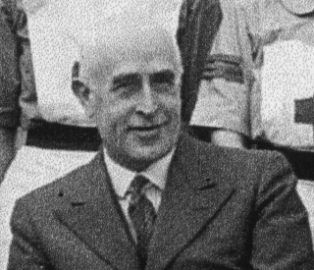 Dr. Horace Hay came to Westerham as a General Practitioner from London in 1931, the year John Ronaldson Russell and Dr. Cotton retired.
Dr. Horace Hay came to Westerham as a General Practitioner from London in 1931, the year John Ronaldson Russell and Dr. Cotton retired.
He initially consulted from his house, Borde Hill (now Old Mill Leat) on Vicarage Hill, until a small independent practice was opened in the High street beside Winterton House. Dr. Hay was joined in this Practice by Tony Winder in 1937, but being a young man, Dr. Winder was called-up for active service in the medical corps in 1939. During the years of the second World War, Dr. Hay was to carry the practice on his own until joined by Aidan Long in 1946 when Tony Winder returned as well. The three of them worked together until the mid-1950s when Dr. Hay retired.
HOOKER Charles
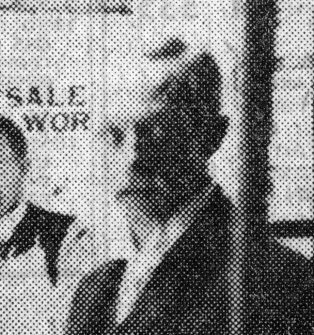 Charles Hooker started his print and stationery business in 1863 whilst he was also working for his stepfather as a bricklayer! In 1864 he produced the first Hooker's Almanack, a veritable Who's Who of trades and residents in the district. It was funded by trader's advertising. The last edition was produced in 1954.
Charles Hooker started his print and stationery business in 1863 whilst he was also working for his stepfather as a bricklayer! In 1864 he produced the first Hooker's Almanack, a veritable Who's Who of trades and residents in the district. It was funded by trader's advertising. The last edition was produced in 1954.
In 1881, Hooker started the Westerham Herald, initially as monthly paper. He became a foremost newspaperman in the town. The front page masthead portrayed a winged messenger bearing a banner entitled "Fama Volat" translating to "the rumour has wings". Within a few years, the popular paper was published weekly, and retained its autonomy until bought out by the Sevenoaks Chronicle in the late 1950s.
JENNER Frank 'Joe'
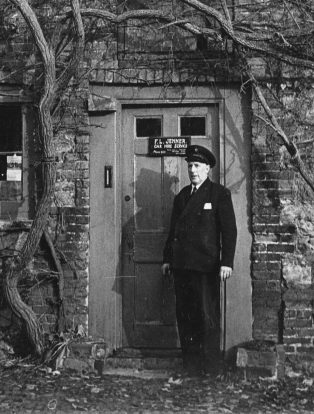
Frank Lewis Jenner was born in Westerham in 1902, the third son of six surviving children. His parents Edward and Sarah lived at Valence Lodge, where his father was a domestic coachman and later chauffeur for the Watney family.
In the late 1920s, Wolfe Garage had run a taxi service from the Kings Arms yard. Len Skinner worked at Wolfe Garage at that time and remembers the young Frank Jenner joining the garage around 1925 as a taxi driver alongside Ron Wells. When Harry Bond took over the proprietorship of Wolfe Garage in 1929 some changes were made, and the taxi service was shut down. Frank ‘Joe’ Jenner raised some backing to continue the business as his own, along with his brother Arthur. There was clearly demand for the work, as he was still running the service some forty-five years later.
It appears that Jenner (always known as ‘Joe’) gained an introduction to Churchill as early as 1922, when the Churchill’s were temporarily living at Hosey Rigge, awaiting the finishing of structural alterations to Chartwell, their recently purchased home. Jenner was summoned to the house where Churchill asked if he could be driven to London. Only too pleased to oblige, Jenner must have made a good impression, as he was to remain principal chauffeur to Downing Street and Westminster until that last journey to Sir Winston’s London home, 28 Hyde Park Gate, in October 1964. Sir Winston passed away in January 1965.
LE MESURIER Sidney
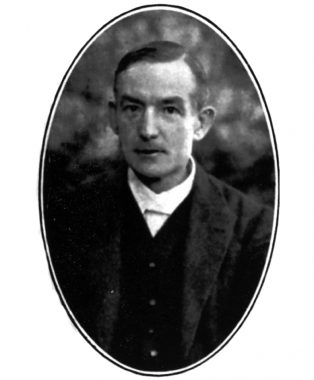 Vicar of Westerham from 1900 following the long incumbency of his predecessor Henry Charles Bartlett, the Revd. Le Mesurier was to see his parishioners and the community through the difficult years of World War I, a conflict from which fifty young men from the town would not return, including William Weller, son of local builder Thomas Weller. William had only married his childhood sweetheart the year before he was sent to France in 1916, and was killed in action during retaliation from a large-scale daylight raid at Givenchy in 1917. He was aged 29 and is buried along with fifteen others of his Battalion at Gorre British and Indian Cemetery, France.
Vicar of Westerham from 1900 following the long incumbency of his predecessor Henry Charles Bartlett, the Revd. Le Mesurier was to see his parishioners and the community through the difficult years of World War I, a conflict from which fifty young men from the town would not return, including William Weller, son of local builder Thomas Weller. William had only married his childhood sweetheart the year before he was sent to France in 1916, and was killed in action during retaliation from a large-scale daylight raid at Givenchy in 1917. He was aged 29 and is buried along with fifteen others of his Battalion at Gorre British and Indian Cemetery, France.
LIDDELL Alice (in Wonderland)
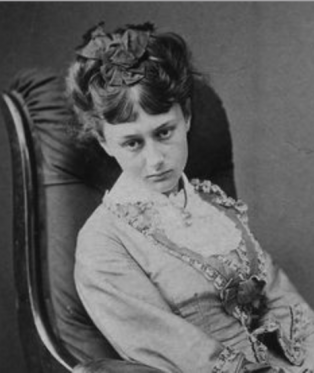 When Alice grew up she was rumoured to have been romantically linked with Queen Victoria’s son and family friend, Leopold. The evidence is slight, but subsequently he did name his daughter Alice, and she named her son Leopold. Alice Liddell died at the Breeches after a short illness. She had come to Westerham following the death of her husband, to be close to her sister Rhoda who lived on Hosey Hill. Listen to a dramatised interpretation from one of Westerham's Talking Town Heritage Sites which is mounted on the gate-pillar outside the house for you to enjoy.
When Alice grew up she was rumoured to have been romantically linked with Queen Victoria’s son and family friend, Leopold. The evidence is slight, but subsequently he did name his daughter Alice, and she named her son Leopold. Alice Liddell died at the Breeches after a short illness. She had come to Westerham following the death of her husband, to be close to her sister Rhoda who lived on Hosey Hill. Listen to a dramatised interpretation from one of Westerham's Talking Town Heritage Sites which is mounted on the gate-pillar outside the house for you to enjoy.
Download a Q.R. code reader app on your mobile smartphone to do this.
LINGSTROM Freda
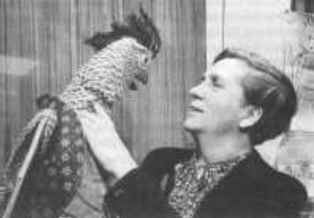 Freda Lingstrom was an artist, illustrator and author who went on to become Head of Children's Television at the BBC. With her friend and companion Maria Bird, she developed the concept of 'Watch with Mother' and the characters within the strand, including Andy Pandy and the Flower Pot Men. Freda and Maria lived at Chartwell Cottage and set up a company called 'Westerham Arts'. A chance meeting and the subsequent conversation on a train between Lingstrom and another of the town's commuters Audrey Atterbury, inspired Atterbury to involve herself with Westerham Arts and train as a puppeteer. She worked on the Watch with Mother series which began in 1951 with Andy Pandy.
Freda Lingstrom was an artist, illustrator and author who went on to become Head of Children's Television at the BBC. With her friend and companion Maria Bird, she developed the concept of 'Watch with Mother' and the characters within the strand, including Andy Pandy and the Flower Pot Men. Freda and Maria lived at Chartwell Cottage and set up a company called 'Westerham Arts'. A chance meeting and the subsequent conversation on a train between Lingstrom and another of the town's commuters Audrey Atterbury, inspired Atterbury to involve herself with Westerham Arts and train as a puppeteer. She worked on the Watch with Mother series which began in 1951 with Andy Pandy.
RHODES Fernande
Mrs Rhodes ran the wool and art-needlework shop at 'Commerce House' next door to what was MacFisheries in the 1950s. A very private person, she was an accomplished amateur cinematographer, and a gifted plantswoman in her domestic life in Beckenham. She would often be visited at her shop in the late 1940s and early 1950s by RAF pilots who she and her French-born husband had helped during the war-years, as they were both resistance workers on the 'chain-home' repatriation programme that, had they been caught, would have cost them their lives in front of a German firing squad.
STREATFEILD Harry
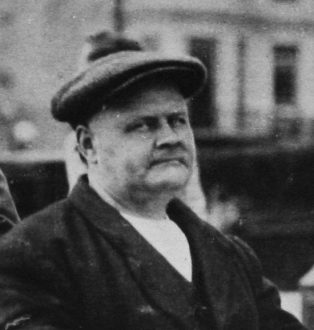 A local man disabled from birth, Harry would often be seen being pushed round the town in his old-fashioned bath-chair by his devoted sister Alice. Harry was descended from the poorer side of the large Streatfeild dynasty, many of whom were living around Chiddingstone, Penshurst and Westerham. Harry was often regarded as the town's diarist, as he would make notes on all of the comings and goings of the district, be it the weather, building developments, society weddings or records on local businesses and trades and what they were up to.
A local man disabled from birth, Harry would often be seen being pushed round the town in his old-fashioned bath-chair by his devoted sister Alice. Harry was descended from the poorer side of the large Streatfeild dynasty, many of whom were living around Chiddingstone, Penshurst and Westerham. Harry was often regarded as the town's diarist, as he would make notes on all of the comings and goings of the district, be it the weather, building developments, society weddings or records on local businesses and trades and what they were up to.
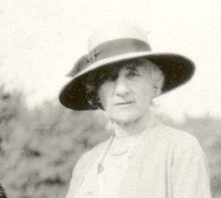 STREATFEILD Lucy Deane
STREATFEILD Lucy Deane
A powerful, well connected woman who married into the Streatfeild dynasty. Lucy had a formidable career working within the National Health Society. She became H.M. Inspector of Factories where she campaigned for rights for British factory workers at home and abroad. Lucy Streatfeild was an active supporter of the women's suffrage movement and had lectured for the National Union of Women's Suffrage. In 1913 she was one of the organisers of the women's suffrage pilgrimage from the Westerham area to join the Union rally attended by 50,000 people in Hyde Park on July 26. At the end of the first World War she was appointed Chair of a committee of enquiry into the conduct of members of the Women's Army Auxiliary Corps in France, and was awarded a CBE for her work. In 1920 she became one of the country's first female Justices of the Peace, serving on the Sevenoaks Bench.
As President of the local branch of the West Kent Agricultural Committee in 1918, she was instrumental in starting Westerham's Women's Institute, an early branch of this not-to-be-underestimated movement alongside Eleanor Joy Busk and other influential contemporaries.
VERRALL George
A Westerham blacksmith who was also a plumber and heating engineer. His name will forever be associated with the infamous Verralls Corner on the A25. Here is picture of his son Hubert Verrall, working at the forge around 1934.
WARDE Charles Arthur Madan
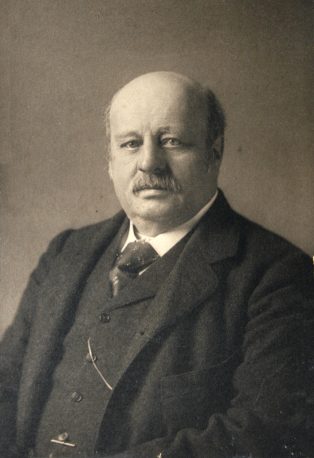 Charles Arthur Madan Warde was born in Neath, Glamorgan in 1839. Aged forty years and then resident at Squerryes Court, he married Hon. Anastasia Kathleen Lucia O'Brien, daughter of Lucius O'Brien, 13th Baron of Inchiquin and the Hon. Louisa Finucane of Dromoland Castle, Co. Clare in Ireland.
Charles Arthur Madan Warde was born in Neath, Glamorgan in 1839. Aged forty years and then resident at Squerryes Court, he married Hon. Anastasia Kathleen Lucia O'Brien, daughter of Lucius O'Brien, 13th Baron of Inchiquin and the Hon. Louisa Finucane of Dromoland Castle, Co. Clare in Ireland.
They had five children, Mary Kathleen b. 1880, Dorothy Louisa b. 1883, Blanche Theresa b. 1885, Evelyn Victoria b. 1895 and John Roberts O'Brien - John St Andrew Warde's father.
In 1912, Charles and Anastasia's second-eldest daughter Dorothy married Albert Harold Octavius Streatfeild, then estates manager for the Warde family.
WARDE Blanche Theresa
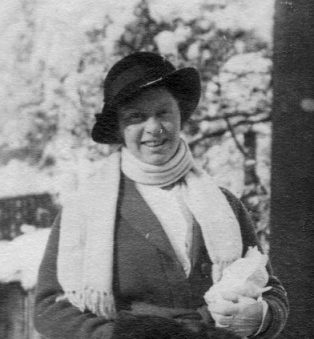
Blanche Warde
Blanche Theresa Warde, third-eldest daughter of Charles and Anastasia was to become an influential woman in the circles of Voluntary Aid Detachment (V.A.D) hospitals in the first World War.
She was given a Red Cross Brassard in October 1914 and received a certificate recognising her valuable services rendered during the Great War from the Red Cross and St John. She was registered as a V.A.D nurse under the National Registered Act 1915 and awarded a War Service Bar in November 1916 while she was at Dunsdale Hospital, Westerham. She was given permission to wear the uniform and badges of a V.A.D serving nurse in March 1917 as authorised under the Defence of the Realm while she was stationed at Ashridge V.A.D Hospital in Hertfordshire.
WELLER Thomas Henry
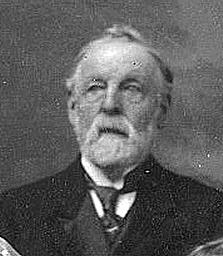 Born in Oxted in 1848, Weller was site foreman and master stonemason on the building of Moreton's Almshouses in London Rd. He was contracted to an Oxted firm of builders who went into receivership and could not pay him on completion of the almshouses. As compensation, he was given the effects of the firm and the client goodwill. As a moderately new builder in Westerham, he built a showcase of twelve semi-detached houses in Westbury Terrace beginning in 1897. He became a landowner and retained some twenty-three houses the firm had built, which he let-out to tenants mostly in London Rd and on the High Street. Weller and sons built over sixty houses in the town prior to his death in 1927. He had his builders yard and undertaking business in the HIgh Street, an area now immortalised as Wellers Close. Here is a photograph of Thomas Weller standing outside his yard waiting to 'clock-in' his workmen for the day's shift.
Born in Oxted in 1848, Weller was site foreman and master stonemason on the building of Moreton's Almshouses in London Rd. He was contracted to an Oxted firm of builders who went into receivership and could not pay him on completion of the almshouses. As compensation, he was given the effects of the firm and the client goodwill. As a moderately new builder in Westerham, he built a showcase of twelve semi-detached houses in Westbury Terrace beginning in 1897. He became a landowner and retained some twenty-three houses the firm had built, which he let-out to tenants mostly in London Rd and on the High Street. Weller and sons built over sixty houses in the town prior to his death in 1927. He had his builders yard and undertaking business in the HIgh Street, an area now immortalised as Wellers Close. Here is a photograph of Thomas Weller standing outside his yard waiting to 'clock-in' his workmen for the day's shift.
WELLER Timothy Osborne
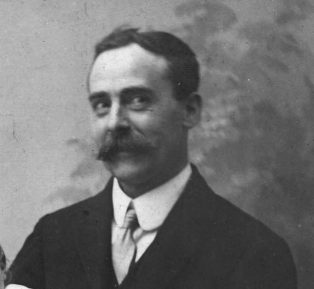 Eldest son of Thomas and Sarah, Timothy Weller was a carpenter and joiner in his father's builders and undertakers business.
Eldest son of Thomas and Sarah, Timothy Weller was a carpenter and joiner in his father's builders and undertakers business.
Here is a photograph of him with his wife Jesse and their children Annie Marjorie, Gilbert Stanley, Millicent Marion, John Osborne and George Thomas.
The family portrait was taken by their next-door neighbour photographer Frederick Benson in his 'Keswick Studio' just before the first World War. At the start of the second World War, his sons Gilbert and John, both working for their father, took the decision to join-up with the armed forces. Weller was so furious he swore he would cut them out of the family inheritance, but the reality may well have been the fact that he had lost his brother to hostilities twenty years before.
WELLER William Arthur
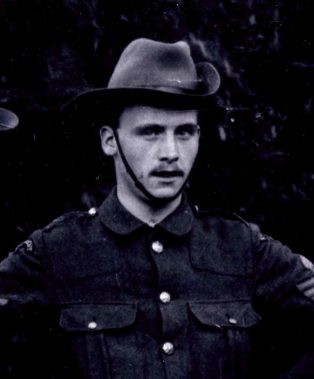 The second eldest son of Thomas and Sarah, William had been a prominent member of the Cadet Corps where he rose to the rank of Colour Sergeant. He served with the Territorials from the outbreak of war before transferring as a Corporal to the 1st Battalion, Royal West Kent Regiment. He was killed in action during a counter-bombardment from German forces following a battalion-strength daylight raid on enemy lines at Givenchy in France on February 10th 1917. He was aged 29, and what was even more tragic for the family at home was the fact that he had married his childhood sweetheart in 1916, the year he was sent to the Front. Along with fifteen others who lost their lives in his Battalion, William is buried at Gorre British and Indian Cemetery in France.
The second eldest son of Thomas and Sarah, William had been a prominent member of the Cadet Corps where he rose to the rank of Colour Sergeant. He served with the Territorials from the outbreak of war before transferring as a Corporal to the 1st Battalion, Royal West Kent Regiment. He was killed in action during a counter-bombardment from German forces following a battalion-strength daylight raid on enemy lines at Givenchy in France on February 10th 1917. He was aged 29, and what was even more tragic for the family at home was the fact that he had married his childhood sweetheart in 1916, the year he was sent to the Front. Along with fifteen others who lost their lives in his Battalion, William is buried at Gorre British and Indian Cemetery in France.
WOLFE James
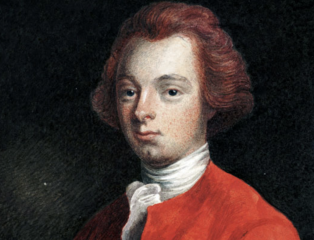 Born in Westerham in 1727, James Wolfe became internationally famous for leading the British Army to victory against the French in Quebec in Canada in 1759. Read the story of Wolfe and his times on the Visit Westerham website. The house where he lived with his parents and his brother is now Quebec House a name it gained in the early 1800s, having been known as 'Speirs' in Wolfe's time. Quebec House is now a National Trust property which contains many artefacts, documents and paintings from the time of the young victor of Quebec.
Born in Westerham in 1727, James Wolfe became internationally famous for leading the British Army to victory against the French in Quebec in Canada in 1759. Read the story of Wolfe and his times on the Visit Westerham website. The house where he lived with his parents and his brother is now Quebec House a name it gained in the early 1800s, having been known as 'Speirs' in Wolfe's time. Quebec House is now a National Trust property which contains many artefacts, documents and paintings from the time of the young victor of Quebec.